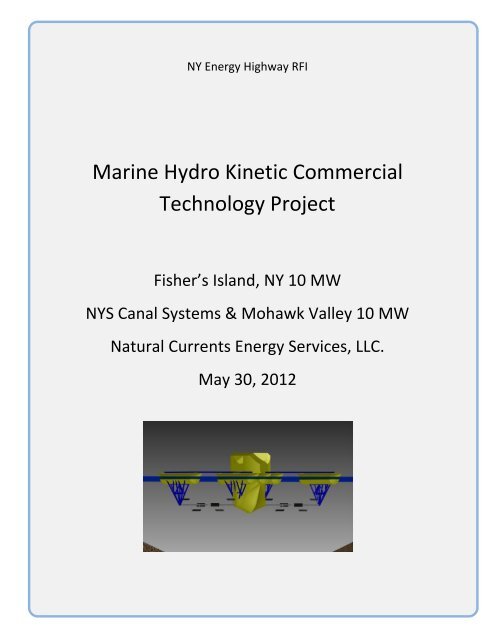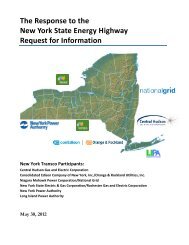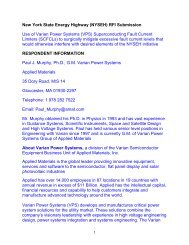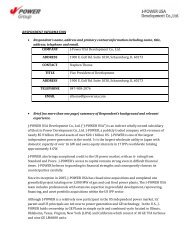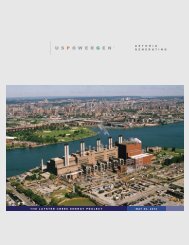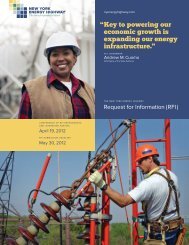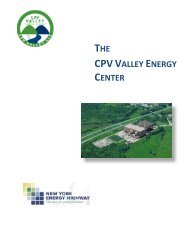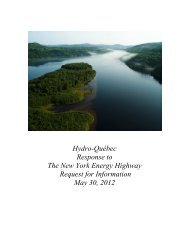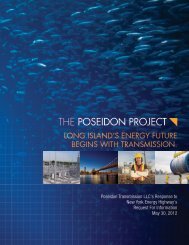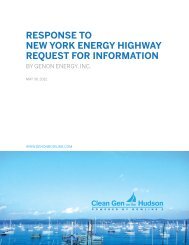Fishers Island Tidal Energy Project - Energy Highway
Fishers Island Tidal Energy Project - Energy Highway
Fishers Island Tidal Energy Project - Energy Highway
Create successful ePaper yourself
Turn your PDF publications into a flip-book with our unique Google optimized e-Paper software.
NY <strong>Energy</strong> <strong>Highway</strong> RFI<br />
Marine Hydro Kinetic Commercial<br />
Technology <strong>Project</strong><br />
Fisher’s <strong>Island</strong>, NY 10 MW<br />
NYS Canal Systems & Mohawk Valley 10 MW<br />
Natural Currents <strong>Energy</strong> Services, LLC.<br />
May 30, 2012
May 30, 2012 NYS TIDAL ENERGY DEVELOPMENT NY ENERGY HIGHWAY<br />
I. Respondent Information<br />
a. Natural Currents <strong>Energy</strong> Services, LLC<br />
b. 24 Roxanne Boulevard, Highland, NY 12528<br />
c. Roger Bason, Founder and President (O) 845-691-4008, (M) 845-674-6544<br />
d. rbason@naturalcurrents.com<br />
e. Brief Bio<br />
Roger Bason Bio - Roger Bason, President and Founder of Natural Currents, has directed over twenty<br />
significant tidal energy technology related projects over the past ten years. He has initiated and<br />
developed innovative approaches for in-stream hydroelectric project systems analysis, site evaluation,<br />
component construction, field-testing, performance and marine impact analysis and permitting for<br />
projects proposed in five states including Alaska, Washington, New York, New Jersey and Massachusetts.<br />
Bason has served as Adjunct Professor at the School of International Public Affairs (SIPA) Center for<br />
<strong>Energy</strong>, Marine Transportation and Public Policy at Columbia University (2002 – 2004) where he taught<br />
interdisciplinary graduate workshops in tidal energy.<br />
He has directed intern programs in the practical study of tidal energy for students from 14 colleges and<br />
universities including Columbia, Vassar, Bard, SUNY Maritime, SUNY New Paltz, MIT, USC, Penn State<br />
and others. He is a leader in the field of sustainable development and has served as president of the<br />
Institute for a Sustainable Future while directing the Hawaii Ameri-Corps program from 1995 - 1996.<br />
Bason is an advisor to the Partnership for Small <strong>Island</strong> Developing States at the United Nations. He has<br />
provided expert consultation to the Long <strong>Island</strong> Power Authority, US Job Corps and the New and<br />
Renewable <strong>Energy</strong> Centre (NaREC) in Blythe, Northampton, UK, a leader in the ocean energy field.<br />
Recent work includes tidal site assessments for the Duchy of Cornwall on the rivers Tamar and Dart in<br />
SW England. Bason directs the development of a Renewable <strong>Energy</strong> Park facility (wind-solar-tidal<br />
demonstration) in coordination with the NYC Parks Department and the US DOE scheduled for<br />
completion in 2014. This project includes the installation of wind, solar and tidal electric equipment for<br />
public education, training and research on environmental impacts on the East River in the heart of NYC.<br />
Fig-1. Testing NC Dragon Fly 10 kW <strong>Tidal</strong> Turbine.<br />
Fig-2. NC <strong>Tidal</strong> <strong>Energy</strong> Site, Hell Gate, East River, NY<br />
2
May 30, 2012 NYS TIDAL ENERGY DEVELOPMENT NY ENERGY HIGHWAY<br />
II.<br />
<strong>Project</strong> Description<br />
a. Type of <strong>Project</strong> - Marine Hydro Kinetic (MHK) Power Generation<br />
i. <strong>Fishers</strong> <strong>Island</strong>, New York – <strong>Tidal</strong> <strong>Energy</strong> <strong>Project</strong><br />
ii. NYS Barge Canal - Mohawk Valley MHK <strong>Project</strong><br />
b. <strong>Project</strong> Size<br />
i. <strong>Fishers</strong> <strong>Island</strong> <strong>Tidal</strong> <strong>Energy</strong> <strong>Project</strong> – 10 MW<br />
ii. Mohawk Valley MHK <strong>Project</strong> – 10 MW<br />
c. Proposed Location<br />
i. <strong>Fishers</strong> <strong>Island</strong>, New York – Off shore in The Race waterway<br />
ii. Mohawk Valley – 14 locations between Little Falls, NY and Albany, NY<br />
d. Fuel Source<br />
i. <strong>Fishers</strong> <strong>Island</strong> – <strong>Tidal</strong> Flow in The Race<br />
ii. Mohawk Valley – Locks, Bridges and Barge Canal Water Flows<br />
e. Earliest Date Operational<br />
i. <strong>Fishers</strong> <strong>Island</strong> – 2014 – First Units Installed with expedited regulatory review<br />
ii. Mohawk Valley – 2014 – First Units Installed with expedited regulatory review<br />
f. Experience with <strong>Project</strong> Technology<br />
Natural Currents (NC) proposes two 10 MW projects to provide commercial grade MHK power to two<br />
regions in NYS. The Mohawk Valley site proposes to install 10 MW of MHK along a six county region in<br />
central NYS along flowing waters within the New York State Canal System. The second site encompasses<br />
the off shore region adjacent to <strong>Fishers</strong> <strong>Island</strong> in The Race at the end of Long <strong>Island</strong> Sound. Preliminary<br />
Permits Applications have been made to the Federal <strong>Energy</strong> Regulatory Commission (FERC) for both<br />
locations by Natural Currents <strong>Energy</strong> Services, LLC.<br />
NC has developed three tidal energy systems at various stages of development: 10 kW, 100 kW and a<br />
pilot scale Red Hawk system (20 kW, scalable to 1,000 kW). The 100 kW NC Sea Dragon will be the go to<br />
unit for the proposed installations.<br />
The design team has completed tests including the following component evaluations in the NIIES<br />
Scientific Research Institute (2009) and the TZAGI T-2 Wind Tunnel (2010) in Moscow with water flume<br />
testing connected at Alden Labs in Holden, Massachusetts, USA (2008). The flume testing resulted in a<br />
substantial redesign of the system and additional component testing of redesigned elements. System<br />
component testing has included successful evaluation and design for (1) Blades: [a] Number of blades in<br />
rotors, [b] Angle of blades to tangent optimization, [c] RPM evaluation based on various blade<br />
conditions, [d] U/V tip speed ratio analysis, [e] Blade length performance analysis, [f] Optimizing Blade<br />
chord, [g] Blade profile optimization. [h] Physical testing for elasticity, shearing, tensile, compression<br />
strength. 2) Generator: [a] Inductor placement, [b] Inductor structure and windings, 3) Control Scheme:<br />
[a] Power conditioning equipment selection.<br />
3
May 30, 2012 NYS TIDAL ENERGY DEVELOPMENT NY ENERGY HIGHWAY<br />
III.<br />
<strong>Project</strong> will address the NYS <strong>Energy</strong> <strong>Highway</strong> Goals and Objectives as follows:<br />
New York State is richly endowed with abundant hydropower resources that currently provide<br />
approximately 18% of the states electricity generation 1 , most of which comes from two hydropower<br />
facilities (2300 MW) at Niagara Falls. While this is a significant achievement for NYS, there are many<br />
additional untapped hydropower resources that are ignored or underutilized. Cutting edge technology in<br />
the field of Marine Hydro Kinetic (MHK) power generation enables a future of distributed generation of<br />
hydropower using flexibly deployed MHK turbines that can provide widespread economic stimulus in<br />
the form of energy savings, job growth and manufacturing revenues. NC has been a leader in the field of<br />
MHK technology development.<br />
With the support of the USDOE, knowledge gained from the Wards <strong>Island</strong> <strong>Tidal</strong> Demonstration <strong>Project</strong><br />
begun in 2012 will contribute benefits to diverse regions throughout New York State. The proposed<br />
projects will use these Wards <strong>Island</strong> project findings to establish standard methods for system<br />
installation, component performance, maintenance, reporting, environmental monitoring and financial<br />
cost. These proposed initial projects can eventually benefit regions including communities along upstate<br />
New York rivers as well as parts of the extensive 534-mile (860 km) NYS canal system and selected<br />
locations along the 1,850 miles (2977 km) of NYS tidal shoreline 2 .<br />
Many cooperating strategic partners engaged in the planning and development of this project include<br />
the engineering team at FALA, Inc located in Kingston, New York providing system manufacture. George<br />
G. Sharp, Inc has completed the innovative vessel based deployment design. Sharp is the oldest naval<br />
architecture company in the US and is located near Ground Zero in New York City. Natural Currents has<br />
completed system testing and will provide the commercial grade tidal electric turbine. Northstar Marine<br />
Services, Inc will manage the installation at the permitted site on the south shore of Wards <strong>Island</strong> in the<br />
heart of New York City. The Monitoring Team includes Innovation Engineering to evaluate system<br />
power output with consulting support from the Cornell BioAcoustics. Environmental Research and<br />
Consulting, Inc (ERC) will perform the studies and environmental monitoring of the site. Operations and<br />
maintenance are the responsibility of Natural Currents.<br />
New York State downstream supply chain can contribute significantly and also benefit financially from<br />
the manufacture of system components. <strong>Energy</strong> benefits will flow to appropriate state facilities and<br />
agencies, municipalities, counties, and NYS manufacturing associations from either clean energy<br />
generation, jobs generation or manufacturing revenue. Benefits include significant technical<br />
performance knowledge of MHK systems, and feedback on system operations. Economic benefits<br />
include manufacturing revenue, energy savings and job creation. The proposed project forms the basis<br />
of improved public education, technology demonstration and provides a training site location for future<br />
workers in this emerging field from New York Academic Institutions.<br />
Opportunity. New York State has abundant and underutilized kinetic hydropower resources that will<br />
have a more direct and rapid path to commercial development with the success of the proposed <strong>Tidal</strong><br />
Demonstration <strong>Project</strong>s. The aggressive goals of the NYS RPS standards will be easier met with the<br />
added clean power benefits of similar systems that are installed throughout the flowing waterways of<br />
the state.<br />
4
May 30, 2012 NYS TIDAL ENERGY DEVELOPMENT NY ENERGY HIGHWAY<br />
There is an alarming and significant need for economic stimulus in Upstate New York. The 50<br />
Upstate NY counties rank 48 th of 50 states in personal income. Population growth for the region<br />
is 51 st in the US behind all states and the District of Columbia. 3 The proposed demonstration<br />
project can have significant benefits from energy revenues and jobs from the replication of the<br />
project in update regions. These include a broad range of geographic distribution of MHK power<br />
generation for upstate rivers including the Black River, the Genesee River and the St. Lawrence,<br />
among many others.<br />
The NYS Canal System extends for 534 miles through the center of Upstate New York and is now<br />
largely underutilized as a transport system. Selected areas along the canal system can be well<br />
adapted to hydropower generation particularly around the higher speed sections of the locks.<br />
<strong>Energy</strong> revenues from appropriately installed MHK hydro systems can assist in defraying some<br />
of the economic burdens of the system due to the lack of commerce, low user fees and the<br />
maintenance impacts of the aging system.<br />
Shoreline and estuarine areas along the 1,850 of NYS coastal shoreline provide excellent<br />
opportunities for MHK installation. These include the demonstration area of NYC Harbor at Hell<br />
Gate and also many locations along the inlets of the south shore of Long <strong>Island</strong> and above all<br />
else The Race at the east end of Long <strong>Island</strong> Sound. NC estimates a 1,000 MW potential of tidal<br />
power from using less then 10 % of the tidal energy through The Race and the tidal flux around<br />
Shelter <strong>Island</strong>. Such a system would cost approximately $3.5 B and would generate 3.5 Million<br />
MWhrs, which is almost equivalent to the 3.8 Million MWhrs generated by renewable energy<br />
systems statewide in New York 4 .<br />
The primary power systems-related advantage of MHK systems is that they provide base-load<br />
and highly predictable Renewable <strong>Energy</strong> Generation, unlike the load profile of wind or solar<br />
power. NC estimates an excess of 1,000 MW of potentially available tidal energy in NYS coastal<br />
shoreline areas alone. The proposed demonstration project can enable broad replication of the<br />
tidal energy system in this sector alone. The proposed project can clarify costs and present<br />
standard methods of site analysis, environmental impact as well as system technical and<br />
financial performance that can rapidly accelerate the permitting, social acceptance and investor<br />
understanding and acceptance.<br />
Figure-2. Presents an overview of the project location in the heart of the New York City. The full scope of<br />
the project includes the installation of a Hybrid Renewable <strong>Energy</strong> System on NYC Parks property on the<br />
south shore of Wards <strong>Island</strong>, in a vacant area immediately adjacent to the shoreline. The immediate off<br />
shore location for a tidal turbine is facilitated by an ancient channel that funnels water speeds in access<br />
of 7 knots (3.5m/s) less than 50m from the shoreline (Figure-2). This is a remarkably good location for a<br />
tidal energy system and requires a minimal length of cable to an on-shore Electrical Room located in a<br />
prefabricated Interpretive Kiosk to house a project office and signage for public education of the Hybrid<br />
RE System operation for 5 kW Solar pV, 100 kW wind and 100 kW <strong>Tidal</strong> energy (Figure-3).<br />
5
May 30, 2012 NYS TIDAL ENERGY DEVELOPMENT NY ENERGY HIGHWAY<br />
Figure-3. Detail of NC Sea Dragon.<br />
Figure-4. Scaled Drawing of NC Sea Dragon at Wards <strong>Island</strong><br />
Figure-5. Site Map of Mohawk Valley<br />
Figure-6. Site Map Fisher’s <strong>Island</strong><br />
6
May 30, 2012 NYS TIDAL ENERGY DEVELOPMENT NY ENERGY HIGHWAY<br />
IV.<br />
Financial<br />
Revenue <strong>Project</strong>ions – 20 MW Installed in NYS<br />
Site<br />
MW Installed<br />
2014<br />
MW Installed<br />
2015<br />
MW Installed<br />
2016<br />
MW Installed<br />
2017<br />
MW Installed<br />
2018<br />
<strong>Fishers</strong> <strong>Island</strong> (CF=.4) 1 8 20 20 20<br />
NYS Canal (CF = .8) 1 8 20 20 20<br />
Revenue<br />
$300 MW-hr<br />
<strong>Fishers</strong> <strong>Island</strong> $1,051,200 $8,409,600 $21,024,000 $21,024,000 $21,024,000<br />
NYS Canal $2,102,400 $16,819,200 $42,048,000 $42,048,000 $42,048,000<br />
Revenue<br />
$150 MW-hr<br />
<strong>Fishers</strong> <strong>Island</strong> $525,600 $4,204,800 $10,512,000 $10,512,000 $10,512,000<br />
NYS Canal $1,051,200 $8,409,600 $21,024,000 $21,024,000 $21,024,000<br />
Financial projections for revenue are presented above. The capacity factor (CF) for power production for<br />
the <strong>Fishers</strong> <strong>Island</strong> <strong>Project</strong> is 40% or 0.4. The CF for the run of river aspect of the NYS Canal installation is<br />
80% or 0.8. Total cost for system installation using the JEDI model described below is $4.72M per MW<br />
installed or $94.4M for the projected 20 MW installed altogether.<br />
The Jobs and Economic Development Intuitive (JEDI) model was developed in conjunction with the<br />
National <strong>Energy</strong> Research Laboratory (NERL) and the Minnesota IMPLAN group to provide an economic<br />
impact forecast for renewable energy products. The nameplate production capacity was based on a<br />
10MW build out. The total cost according to JEDI for 10MW would be 47.2 million dollars. The build out<br />
would then lead to 247 jobs in the state per every 10MW installed. Local spending would be 34.3<br />
million during the 18-month construction period and the future total operating maintenance cost per a<br />
year is 3.4 million workers in New York State. This would lead to a significant amount of well paying<br />
sustainable jobs in New York State.<br />
7
May 30, 2012 NYS TIDAL ENERGY DEVELOPMENT NY ENERGY HIGHWAY<br />
V. Permit Process<br />
Regulatory Overview: The modern era of tidal and wave energy development is in its infancy. While<br />
technology development is advancing in some 20 nations around the world, the application of TISEC<br />
(<strong>Tidal</strong> In-Stream <strong>Energy</strong> Conversion) and WEC (Wave <strong>Energy</strong> Conversion) systems have few installed<br />
commercial scale systems by which to evaluate the regulatory process. Most projects are pilot and<br />
demonstration scale systems that form the basis for historical review of the regulatory process.<br />
Approximately fifteen (15) federal, state, and local resource agencies have been identified to date<br />
that have some oversight and may evaluate potential tidal and wave energy projects with respect to<br />
potential environmental impacts or regulatory jurisdiction for permitting. An initial review of the<br />
responsibilities of each of these agencies has been conducted. Preliminary evaluations to date have<br />
requested a generalized view and understanding with respect to key concerns such as threatened<br />
and endangered species, navigational issues, impacts on sediments and benthos, public safety and<br />
among other issues.<br />
Cooperative agencies for environmental impact assessments include:<br />
US Army Corps of Engineers – US ACE<br />
US Fish and Wildlife Service – US FWS<br />
US Coast Guard – USCG<br />
National Oceanic and Atmospheric Administration – NOAA<br />
Federal <strong>Energy</strong> Regulatory Commission – FERC<br />
National Marine Fisheries - NMF<br />
New York State Department of Environmental Conservation – NYS DEC<br />
New York State Department of State – NYS DOS per SEQR<br />
New York State Coastal Management Program – NYS CMP<br />
Local Community Planning Boards<br />
FERC Authority on <strong>Tidal</strong> <strong>Energy</strong> <strong>Project</strong>s<br />
Several key issues are emerging in the field of system permitting in the United States. Most critical at<br />
this time are developments within the Federal <strong>Energy</strong> Regulatory Commission.<br />
Pursuant to Part I of the Federal Power Act of 1978 (FPA), FERC has authority to issue preliminary<br />
permits and licenses for the construction and operation of hydroelectric projects on navigable waters,<br />
public lands and reservations or which impact interstate commerce through interconnection to the<br />
electric grid or interstate commerce.<br />
Currently FERC provides a 3-year window to complete related studies for companies developing given<br />
tidal or wave energy sites. These preliminary permits may be extended an additional 3 years making a<br />
total of six (6) years for system development and related environmental studies. Many view this process<br />
as so long as to deter private investment.<br />
The time involved for permitting is further lengthened because many agencies do not yet have a<br />
knowledge base or precedent for reviewing this relatively new and emerging technology. A Preliminary<br />
FERC Permit gives companies incentive to take the risk of investing money to gather necessary data and<br />
8
May 30, 2012 NYS TIDAL ENERGY DEVELOPMENT NY ENERGY HIGHWAY<br />
prepare a license application. The Preliminary FERC Permit guarantees the company an exclusive right to<br />
file a license application during the term of the permit and a first-filed priority over later filing<br />
competitors.<br />
As of December, 2006 FERC is re-evaluating the criteria by which preliminary applications for tidal and<br />
wave energy sites are evaluated. It is expected that any changes in site permitting procedures will be<br />
published in early 2007. Some observers state that the overall problem is that the traditional FERC<br />
permitting approach stretches back almost 100 years and is no longer applicable to the emerging field of<br />
tidal and wave energy development. These issues are being reviewed by the Ocean Renewable <strong>Energy</strong><br />
Coalition as well as many interested commercial interests in the emerging tidal and wave industry. The<br />
chart below provides a view of jurisdictional areas with impacts on tidal and wave energy development.<br />
Additional Federal Oversight<br />
Federal Power Act, 16 U.S.C. § 817 (1) - FERC Authority and Jurisdiction<br />
The Federal <strong>Energy</strong> Regulatory Commission (FERC) statutory authority states “it shall be unlawful for any<br />
person…for the purpose of developing electric power, to construct, operate or maintain any dam,<br />
…reservoir or powerhouse or other works across navigable waters of the United States….except in<br />
accordance with a license …*issued by FERC+. FERC has also determined that a wave energy project is a<br />
hydro project with a “power house” over which it has jurisdiction. Likewise FERC has jurisdiction over<br />
tidal and ocean current power projects up to three miles off shore. In 2005, FERC created the “Verdant<br />
exemption” which allows developers to deploy wave and tidal projects on an experimental basis, for a<br />
limited time frame (the initial exemption was for 18 months) provided that developers do not impact<br />
commerce by selling power to the grid and deploy projects to gather data for licensing. FERC must also<br />
give “equal consideration” to environmental and energy concerns (Sec. 4(e) of FPA, 16 U.S.C.§ 797) and<br />
be “best adapted to a comprehensive plan for developing a waterway, for protecting fish and wildlife<br />
and for other beneficial uses such as recreation, irrigation, water supply “(Sec 10 (a) FPA, 16 U.S.C. § 803<br />
a).<br />
U.S. Army Corps of Engineers<br />
Section 10 of the Rivers and Harbors Act of 1899 - 33 U.S.C. 403<br />
Section 10 states that the creation of any obstruction not affirmatively authorized by Congress, to the<br />
navigable capacity of any of the waters of the United States is prohibited; and it is unlawful to build or<br />
commence the building of any wharf, pier, dolphin, boom, weir, breakwater, bulkhead, jetty, or other<br />
structures in any port, roadstead, haven, harbor, canal, navigable river, or other water of the United<br />
States, outside established harbor lines, except on plans recommended by the Chief of Engineers. Also,<br />
it is unlawful to excavate or fill, or in any manner to alter or modify the course, location, condition, or<br />
capacity of, any port, roadstead, haven, harbor, canal, lake, harbor of refuge, or enclosure within the<br />
limits of any breakwater, or of the channel of any navigable water of the United States, unless the work<br />
has been recommended by the Chief of Engineers.<br />
33 U.S.C. § 404 – Dredge and Fill Permit<br />
9
May 30, 2012 NYS TIDAL ENERGY DEVELOPMENT NY ENERGY HIGHWAY<br />
A 404 permit (Section 404 “dredge and fill) permit from the Corps of Army Engineers may be required<br />
for FERC projects, but is only applicable up to the three (3) mile offshore limit. Structures that impact<br />
and are sited within navigable waterways are clearly the jurisdiction of the ACE. <strong>Project</strong>s involving such<br />
development must be reviewed by the ACE and permitted prior to installation as established by the<br />
Rivers and Harbors Act of 1890 and 1899.<br />
US Coast Guard (USCG) Regulations<br />
33 C.F.R. Part 62, 64, 66 Marine Navigation Lights<br />
These regulations require and specify navigation lights must be posted on pilot, demonstration and<br />
commercial wave and tidal projects that may impact marine navigation and require that they be visible<br />
for one mile. The USCG would make a determination of requirements regarding the markings, lights and<br />
fog signals that would be appropriate for a given system deployment.<br />
National Environmental Policy Act (NEPA)<br />
42 U.S.C. § 4332 ( c ) Environmental Impact Statement<br />
NEPA requires preparation of an Environmental Impact Statement (EIS) for “major federal actions<br />
significantly affecting the quality of the human environment.” An environmental assessment (EA) must<br />
be prepared to determine if an EIS is necessary. Both the EA and the EIS must consider alternatives<br />
(build, no build, alternate location) and a variety of socio-economic, environmental and cultural impacts.<br />
The Federal Power Act allows licensees to retain “third party contractors” on agency’s approved list to<br />
prepare the EA or the EIS.<br />
Coastal Zone Management Act – (CZM)<br />
16 U.S.C. § 1374 – CZM Consistency Finding<br />
Coastal States with approved CZM plans must issue a “consistency finding” that confirms that the<br />
proposed project is consistent with the state’s CZM Plan. The Secretary of Commerce can consider<br />
whether to overrule the state’s inconsistency finding if the applicant seeks review. The FERC license will<br />
not be issued without a consistency finding. Coastal Zone Management Act (CZMA) of 1972 will involve<br />
three additional agencies that include (1) US Fish and Wildlife Service – US FWS, (2) National Oceanic<br />
and Atmospheric Administration – NOAA, and (3) National Marine Fisheries - NMF<br />
National Historic Preservation Act<br />
16 U.S.C. § 470 Protection of Historic Resources<br />
If it is determined that there is a possible impact on historic resources, an evaluation of the project’s<br />
potential impact on these resources must be completed in consultation with the state historic<br />
preservation agencies.<br />
Fish and Wildlife Coordination Act<br />
10
May 30, 2012 NYS TIDAL ENERGY DEVELOPMENT NY ENERGY HIGHWAY<br />
16 U.S.C. § 661 Fish and Wildlife Impacts<br />
This act requires consultation with federal and state fish and wildlife agencies where a federal project<br />
impacts a body of water. FERC has its own independent consultation requirements under Section 10 (I)<br />
of the Federal Power Act.<br />
Endangered Species Act (ESA)<br />
16 U.S.C. § 1531 Endangered Species Impact<br />
Section 7 of the ESA requires consultation with the Secretary of the Interior prior to project<br />
development to determine if endangered species may be present or adversely impacted by the project<br />
development.<br />
Marine Mammals Protection Act<br />
16 U.S.C. § 1361 – 1407 Harassment of Endangered Mammals<br />
This federal law prohibits the harassment, hunting or capture of depleted endangered marine mammals.<br />
The project must prove that it does not “harass” protected marine mammals.<br />
Submerged Land Act<br />
43 U.S.C. § 1301 – Lease for Use of State Lands<br />
The application of this law depends on the project location. At a minimum, the land lease would be<br />
required for transmission lines to shore. Also, under the FPA, 16 U.S.C. § 814, licensee has the power of<br />
eminent domain, which could possibly be used to acquire state lands. It should also be noted that<br />
eminent domain authority has never been tested for in such an application.<br />
Production Tax Credits<br />
Section 45 IRS Code Renewable <strong>Energy</strong> Production Incentive (REPI)<br />
The REPI would apply for tidal and wave energy projects and is structured such that municipal entities<br />
may receive cash reimbursements from the federal government for capital projects which include<br />
production of power from renewable energy sources.<br />
11
May 30, 2012 NYS TIDAL ENERGY DEVELOPMENT NY ENERGY HIGHWAY<br />
VI.<br />
Other Considerations<br />
- Regulatory reform has begun in the field of Marine Hydro Kinetic technology with<br />
progressive action by the US ACE and reforms of the NEPA process.<br />
- These reforms have served to reduce the time to process the necessary permits and<br />
enable a Nationwide Permitting Process to proceed.<br />
- NYS should support this process with the following actions:<br />
o<br />
o<br />
o<br />
o<br />
Form a State Wide Task Force for MHK Regulatory Reform.<br />
Recommend Actions that streamline permitting and adjust requirements to<br />
National Standards set by the US ACE, FERC, NMFS.<br />
Establish a NYS wide monitoring program of environmental factors based on<br />
international recommendations for assessing marine / aquatic impacts.<br />
Establish a State Wide Database required of all projects to catalogue, assess and<br />
compare environmental impacts from statewide monitoring.<br />
- Establish a seven-year (7-year) incentive program to support the price of <strong>Tidal</strong><br />
Generated Power in New York State at $300 per MW-hour. This compares favorably but<br />
does not exceed the price supports via Feed In Tarrifs (FITs) in Nova Scotia ($624 USD /<br />
MW-hr), the United Kingdom ($420 USD / MW-hr), and India (50% of the Costs of MHK<br />
projects supported by India Government).<br />
- After 7 years the price of MHK power should be allowed to float with existing market<br />
conditions and statewide competition.<br />
VII.<br />
Additional Information<br />
1. Property Mohawk Valley MHK <strong>Energy</strong> <strong>Project</strong>. In 1992, the New York State Barge Canal was<br />
renamed the New York State Canal System (including the Erie, Cayuga-Seneca, Oswego, and<br />
Champlain canals) and placed under the newly created New York State Canal Corporation, a<br />
subsidiary of the New York State Thruway Authority. The Canal System is operated using money<br />
generated by Thruway tolls. A total of six (6) central NYS Counties border the proposed project<br />
location, including Herkimer, Fulton, Montgomery, Saratoga, Schenectady and Albany Counties.<br />
2. Property <strong>Fishers</strong> <strong>Island</strong> <strong>Tidal</strong> <strong>Energy</strong> <strong>Project</strong>. The project location is located entirely within<br />
Suffolk County, Long <strong>Island</strong>, New York. The project can foster regional cooperation with the<br />
State of Connecticut and provide power to the NEPOOL.<br />
3. <strong>Project</strong>ed In-Service Date. Permitting can commence with a 24-month lead-time under the best<br />
of circumstances. USACE permits for Nation Wide Permitting of up to 10 MHK units (1 MW) will<br />
be the keystone of early stage development. Under favorable conditions of public outreach and<br />
acceptance, first units installed in late 2014. Build out of the project scope can be completed<br />
during 2015-2016. Detailed scheduling is presented in the FERC Preliminary Permit Applications<br />
12
May 30, 2012 NYS TIDAL ENERGY DEVELOPMENT NY ENERGY HIGHWAY<br />
that has been submitted for both these locations by Natural Currents <strong>Energy</strong> Services, LLC in<br />
early 2012.<br />
4. Interconnection. <strong>Fishers</strong> <strong>Island</strong> <strong>Tidal</strong> <strong>Energy</strong> <strong>Project</strong> interconnection points can be most easily<br />
achieved through a 3-mile cable to the New London area of Connecticut. Cables already exist in<br />
this area. Alternatively a longer cable connection can be made to Orient Point to connect with a<br />
17kV line maintained by LIPA. Mohawk Valley MHK <strong>Project</strong> has many possible connection<br />
points along the six county span of 14 potential installations along the NYS Canal System<br />
between Little Falls and Albany.<br />
5. Base load Renewable <strong>Energy</strong>. Investor owned utilities are responsible for compliance with the<br />
RPS standards in NYS. These organizations can benefit through a greater knowledge of how tidal<br />
energy systems can work in NYS and assist in the process of meeting the RPS goals that we all<br />
share. The project will demonstrate both distributed generation of innovative new hydropower<br />
systems an provide base-load renewable energy that is completely predictable. Predictability is<br />
the life-blood of electric utilities. <strong>Tidal</strong> energy production can be predicted for centuries into the<br />
future with great reliability. This is an important factor for public utilities.<br />
6. Technical. All key components (shaft, rotors, generator) are rated for 20 years lifetime. Biannual<br />
field maintenance program will enable optimal performance. The Natural Currents Sea Dragon<br />
system is vessel-mounted that enables significant flexibility for system installation. For marinas<br />
this enables replacement of seasonal rental slips with year round revenue from tidal energy<br />
systems. New models can be effectively replaced. Equipment can be easily adjusted to Seasonal<br />
variations in tidal flow regimes. System maintenance is facilitated by having the generator<br />
system enclosed within a dry “machine room” in the central hull of the vessel-based system.<br />
Monitoring equipment is installed on the vessel that makes for easier data collection and<br />
transmission. Fish sampling is facilitated as the vessel has a deck from which to work. Workboats<br />
have a structure to tie onto during periods of research vessel sampling. Titanium components<br />
provide for a 20-year life span of equipment. Elastomeric Polymer Bearings have already<br />
demonstrated a 20-year life on hydro projects in Canada, having been used since 1966 in gritty,<br />
sediment-laden environments. The NC Sea Dragon system promises long performance, easy<br />
maintenance and lower costs once mass production manufacture can begin at a later stage.<br />
7. Construction and Manufacturing Location. The tidal energy system will be manufactured in<br />
Kingston, New York at the FALA precision engineering company. This company has<br />
manufactured and tested cross flow wind technology. It has the precision engineering skills and<br />
experience needed to complete the tasks for system assembly. FALA has worked with the types<br />
of processes and metals, particularly titanium required for the tidal energy system design.<br />
Labor. Green-Jobs development program will enable skill set growth and re-training to provide<br />
for the complete spectrum of needed positions. Downstream supply chain can be supplied in<br />
New York State and region. Decommissioning. Vessel-mounted systems enable easy movement<br />
and decommissioning. Replacement systems with evolving and new technology easily<br />
substituted during programmed maintenance cycles. Old systems may be sold in after market<br />
and re-conditioned for developing regions and countries.<br />
8. Operations, Technology Transfer and Replication. After initial project installations, the target<br />
audience is broad for project replication. A key early adopter market that has emerged consists<br />
of marina owners who have “high speed slips” with strong tidal flows. These slips are difficult for<br />
weekend mariners to maneuver and generally rent for less than more favorable locations. These<br />
slips can be used for fixed or vessel mounted NC tidal energy systems. <strong>Project</strong>s are underway at<br />
13
May 30, 2012 NYS TIDAL ENERGY DEVELOPMENT NY ENERGY HIGHWAY<br />
several marinas in New Jersey. The owners are limited to a 5 to 6 month seasonal income from<br />
slip rentals can now consider secondary income from net metered or Power Purchase<br />
Agreement electricity sales. This market is extensive on both a national and international level.<br />
Municipalities with shoreline, estuarine or river-based properties can also significantly benefit<br />
from the development of tidal energy at appropriate sites.<br />
9. Socio-Economic - Estimated New York Commercial Market. The estimated commercial market<br />
for New York State is a minimum of 1,000 MW of installed capacity of these systems or a<br />
minimum total of 10,000 system during the next 20 years. The estimated cost of system<br />
installation averaged for larger projects is $3.5M per MW installed. Therefore the estimated NYS<br />
commercial market is $3.5B over the next 20 years for locations in upstate rivers, along the NYS<br />
canal system and in near shore inlets and high tidal flux areas in New York Harbor and Long<br />
<strong>Island</strong>.<br />
10. Socio-Economic - Potential Application at Other Sites. There is a high potential for application<br />
of this technology at other sites as described above. The proposed demonstration site will<br />
facilitate such applications by enabling a very visible demonstration site in the heart of New York<br />
City to provide a broad range of needed monitoring data for analysis, public information and<br />
system improvement. These include feedback on the ware characteristics of system component<br />
parts over a five (5) year period. Environmental impacts are a key concern of regulatory<br />
agencies. All major environmental impact parameters of international inquiry are assessed by<br />
the proposed project 6 . The evaluations made during this project can serve to streamline the<br />
permitting process by providing incontrovertible and definitive data and proof of the benign<br />
impact of tidal energy systems on the marine ecology. Power output and financial revenue data<br />
will be presented to potential investors. The nascent but world-wide ocean renewable energy<br />
industry will greatly value the monitoring of the system installed at this site. Natural Currents is<br />
presently dealing with both the US Navy and the Royal Navy (UK) on an introductory level to<br />
provide initial information about the value of vessel-mounted tidal energy systems. Rapid<br />
deployment of tidal based electric power after natural disasters may find greater use for future<br />
intervention after natural disasters such as floods, earthquakes and tsunamis. New York State<br />
application of this technology to other sites will be fostered through active public relations,<br />
presentations at conferences and extensive use of social media networking now used by Natural<br />
Currents <strong>Energy</strong> Services, LLC.<br />
11. Regulatory Issues - Barriers to Market Entry. The barriers to market entry include primarily<br />
three (3) factors. These include (1) regulatory hurdles, (2) public understanding and acceptance<br />
and (3) lack of private sector investment. The proposed demonstration site will effectively<br />
improve social acceptance and understanding of environmental impacts that will serve to<br />
reduce regulatory barriers that now require excessive monitoring and time that is very costly at<br />
this stage of industry development. Private sector investors will be encouraged by the finding of<br />
limited, if any, negative environmental impacts and the overall profitability due to lower<br />
maintenance and higher, base-load renewable energy generation.<br />
12. Public Outreach. Natural Currents has presented papers and lectures at significant renewable<br />
and marine industry conferences including the Small Hydro Conference sponsored by the UK<br />
group Green Power Conferences that was held in Washington, DC in December 2010 and the UN<br />
Conference on Global Climate Change in Copenhagen, Denmark in 2009. Natural Currents has<br />
further been invited to present a keynote address at the Small Hydro Conference in Sao Paulo,<br />
Brazil in May 2011. Natural Currents has been a presenter at the Nortek USA conference in<br />
14
May 30, 2012 NYS TIDAL ENERGY DEVELOPMENT NY ENERGY HIGHWAY<br />
Newport Beach, RI in 2011 attended by primarily Marine monitoring equipment manufacturers<br />
and regulatory agencies. Natural Currents has enabled television interviews on <strong>Tidal</strong> <strong>Energy</strong> with<br />
Channel 12 News NJ, NBS News New York in 2010, Lang and O’Leary Financial News for a<br />
Canadian TV Station, Planet Forward interviews which is part of PBS and also several radio<br />
programs on tidal energy including a business profile on American Express Radio program and<br />
radio stations in Boston, New York, New Jersey and California. New York State conferences will<br />
become a point of focus to effectively network project findings in New York State. Regulatory<br />
requirements for public meetings will further engage the public and enable enhanced<br />
understanding of system impacts, controls, monitoring and benefit.<br />
13. <strong>Energy</strong> Benefits<br />
- <strong>Energy</strong> benefits include generation of 82,000 MW hours of electric power annually.<br />
- Completely predictable energy production from known tidal cycles.<br />
14. Environment Benefits<br />
- Direct impacts include the reduction of 155,224 pounds of Nitrogen Oxides per year.<br />
- Benefits include reduction of 310.48 pounds of Sulfur Dioxides per year.<br />
- Direct benefits include the reduction of 56,720 Tons of Carbon Dioxide per year.<br />
15. Other Benefits.<br />
- Potential to streamline permitting process for similar projects due to long term monitoring<br />
- Improved understanding and knowledge of minimal environmental impacts.<br />
- Development of standard protocols for system installation, monitoring and design<br />
- Potential for broad scale commercialization of tidal technology<br />
- Manufacturing of tidal energy systems at New York Based Precision Engineering Company<br />
16. Economic Analysis<br />
Marine Hydro Kinetic (MHK) Jobs and Economic Development Intuitive (JEDI) for New York State<br />
To understand the potential economic impact of Marine Hydro Kinetic (MHK) renewable energy in<br />
the United States the National <strong>Energy</strong> Research Laboratory (NREL) has developed a system that is<br />
called the Jobs and Economic Development Impact (JEDI) model. The model uses the state specific<br />
data files and economic multipliers from the Minnesota IMPLAN group accounting software for<br />
economic forecasts. The factors that IMPLAN uses were gathered through extensive research and<br />
analysis of current industry standards and through interviewing industry professionals.<br />
This JEDI Model for a potential MHK technology project such as installations on the NYS Barge Canal<br />
(the modern version of the old Erie Canal) has been run using New York State data with the inputs<br />
highlighted in green. The assumptions that were made with respect to the manufacturing and<br />
development jobs are highlighted in yellow. All other data is from the IMPLAN data and cannot be<br />
changed in the JEDI model. MW nameplate capacity is 10 MW so for smaller sizes we will assume<br />
that division of numbers by said factor will be accurate. The rate of $/kW is a cost that is derived<br />
from the IMPLAN databases on calculations and research.<br />
15
May 30, 2012 NYS TIDAL ENERGY DEVELOPMENT NY ENERGY HIGHWAY<br />
Marine and Hydrokinetic - <strong>Project</strong> Data Summary based on model default values<br />
<strong>Project</strong> Location<br />
New York<br />
Year of Construction or Installation 2013<br />
Reference System Size - Nameplate Capacity (MW) 10.0<br />
Total <strong>Project</strong> Size - Nameplate Capacity (MW) 10.0<br />
Construction Period (months) 18<br />
System Type<br />
<strong>Tidal</strong> Power<br />
System Cost ($/KW) or ($4.724M per MW installed) $4,724<br />
Annualized O & M Cost (percent of Capital Cost) 7.3%<br />
Money Value (Dollar Year) 2012<br />
<strong>Project</strong> Construction or Installation Cost<br />
$47.2M<br />
Local Spending<br />
$34.3M<br />
Total Annual Operational Expenses<br />
$10.1M<br />
Direct Operating and Maintenance Costs<br />
$3.4M<br />
Local Spending<br />
$2.7M<br />
Other Annual Costs<br />
$6.8M<br />
Local Spending<br />
$0.1M<br />
Debt Payments<br />
$0.0M<br />
Property Taxes<br />
$0.0M<br />
Sales Tax<br />
$0.1M<br />
Jobs<br />
Earnings<br />
Local Economic Impacts - Summary Results<br />
Jobs / Year $MM (2012) Output<br />
During construction and installation period 17.0 $2.2 $MM (2012)<br />
<strong>Project</strong> Development and Onsite Labor Impacts 8.1 $1.1 $3.3<br />
Construction and Installation Labor 9.0 $1.1<br />
Construction and Installation Related Services 150.1 $12.4<br />
Module and Supply Chain Impacts 56.0 $4.0 $41.9<br />
Induced Impacts 223.1 $18.5 $10.3<br />
Total Impacts 223.1 $18.5 $55.5<br />
Annual Earnings Annual<br />
Jobs $MM (2012) Output<br />
During operating years $MM (2012)<br />
Onsite Labor Impacts 9.5 $0.7<br />
Hydro <strong>Project</strong> Labor Only 9.7 $0.9 $0.7<br />
Local Revenue and Supply Chain Impacts 4.7 $0.3 $2.9<br />
Induced Impacts 23.8 $2.0 $0.9<br />
Total Impacts 23.8 $2.0 $4.5<br />
16
May 30, 2012 NYS TIDAL ENERGY DEVELOPMENT NY ENERGY HIGHWAY<br />
*Notes: Earnings and Output values are millions of dollars in year 2012 dollars. Construction period related jobs are full time<br />
equivalent jobs for one year. Based on the 18 month construction period this is an annual average of approximately 149 full time<br />
equivalent jobs. Hydro project labor includes all onsite operators and technicians as well as administration and management.<br />
The analysis does not include impacts associated with plant "profits" and assumes no tax abatement unless noted.<br />
Totals may not add up due to independent rounding. Due to the many uncertainties surrounding these new and emerging<br />
technologies all impacts should be viewed as preliminary and caution applied when reporting results.<br />
Detailed Hydro <strong>Project</strong> Data Costs<br />
Installation Costs<br />
Local<br />
Cost Share (%)<br />
Materials & Equipment $31.1 75%<br />
Device $4.7 50%<br />
Underwater Electrical Collector System $0.5 50%<br />
Underwater Transmission Cable $1.1 50%<br />
Cable Landing and Grid Interconnection $2.0 75%<br />
Balance of Plant $39.3<br />
Subtotal<br />
Installation/Labor $2.5 75%<br />
Mooring and Device Installation $1.0 75%<br />
Underwater Cable Installation $0.5 75%<br />
Cable Landing and Grid Connection $4.0<br />
Subtotal $2.4<br />
Permitting Cost $45.7<br />
Subtotal $1.6 100%<br />
Sales Tax (Materials & Equipment Purchases) $47.2<br />
Total $47.2<br />
Annualized Operating and Maintenance Costs $MM (2012) Local<br />
Share (%)<br />
$0.8 100%<br />
Labor $2.6 75%<br />
Materials and Services $3.4<br />
Subtotal $0.1 100%<br />
Sales Tax (Materials & Equipment Purchases) $0.9 0%<br />
Average Annual Debt Payment (Interest and Principal) $0.0 0%<br />
17
May 30, 2012 NYS TIDAL ENERGY DEVELOPMENT NY ENERGY HIGHWAY<br />
Equity Payment - Individuals $5.8 0%<br />
Equity Payment - Corporate $0.0 100%<br />
Property Taxes $0.0 100%<br />
Lease Cost $10.1<br />
Total<br />
Other Parameters<br />
Financial Parameters<br />
Local<br />
Share (%)<br />
Debt Financing 20% 0%<br />
Percentage financed 20<br />
Years financed (term) 10%<br />
Interest rate<br />
Tax Parameters 0%<br />
Local Property Tax (percent of taxable value) 100%<br />
Assessed Value (percent of construction cost) 100%<br />
Taxable Value (percent of assessed value) $45.7<br />
Taxable Value ( million$ - if applicable) 100.0%<br />
Property Tax Exemption (percent of local taxes) $0.0 100%<br />
Local Property Taxes 4.0% 100%<br />
Local Sales Tax Rate $0.0 100%<br />
Lease Cost (if applicable)<br />
* Spreadsheet is taken from JEDI software output<br />
Impacts in New York State - Assumptions<br />
MW<br />
Size<br />
<strong>Tidal</strong> Turbine Has a .4 Capacity Factor<br />
Turbines run for 365 days a year 24 hours a day<br />
<strong>Project</strong> Sourcing is Highlighted above in Yellow<br />
$300 MWhr Incentive<br />
Cost per<br />
MW<br />
Jobs<br />
Created<br />
per 1<br />
MW<br />
Cost for<br />
Build Out<br />
Total<br />
Jobs<br />
Created<br />
kWhr<br />
Produced<br />
MWhr<br />
Incentive<br />
Annual<br />
Revenues<br />
SPB<br />
Years<br />
1 $4,723,968 25 $4,723,968 25 3,504,000 $300 $1,051,200 4.49<br />
5 $4,723,968 25 $23,619,840 123 17,520,000 $300 $5,256,000 4.49<br />
10 $4,723,968 25 $47,239,680 247 35,040,000 $300 $10,512,000 4.49<br />
Summary. By implementing an incentive of $300 MWhr we are able to reach our goal of a 5-year<br />
simple pay back (SBP). This is an important goal for new technologies and it is imperative that such<br />
policies be enacted to foster economic growth and technology development. This SBP allows for more<br />
investment into the industry that will lead to further economic and social benefits.<br />
18
May 30, 2012 NYS TIDAL ENERGY DEVELOPMENT NY ENERGY HIGHWAY<br />
References<br />
1 Bleiwas, Kenneth. Energizing the Future: The Benefits of Renewable <strong>Energy</strong> for New York State.<br />
Report 12-2005. Office of State Deputy Controller. March 2005.<br />
2 US Department of Commerce. NOAA. National Ocean Service. 1940.<br />
3 US Census Bureau. Personal Income Upstate NY 2008 (50 non-MTA Region Counties). Population<br />
Growth Upstate New York during 2000 to 2009. The Public Policy Institute of New York State, Inc.<br />
Albany, New York. June 2010.<br />
4 NYSERDA. New York State Reneewable Portfolio Standard. Performance Report. Program Period<br />
ending June, 2008. September 2008.<br />
6 Gill, A.B. Offshore Renewable <strong>Energy</strong>: Ecological Implications of Generating Electricity in the Coastal<br />
Zone. Journal of Applied Ecology. 2005. 42: 605-615.<br />
Related Documents on <strong>Tidal</strong> <strong>Energy</strong><br />
Bason, R. (2011 February). ADP Measurements of Spacial <strong>Tidal</strong> Flow in the Shrewsbury River Near Sandy<br />
Hook. (N. C. Services, Ed.) Potential <strong>Tidal</strong> Power for New Jersey 2010-15 .<br />
Bason, R. (2011, February). ADP Measurements of Spacial <strong>Tidal</strong> Flow in the Shrewsbury River<br />
Near Sandy Hook. (N. C. Services, Ed.) Potential <strong>Tidal</strong> Power for New Jersey .<br />
< http://issuu.com/naturalcurrents/docs/report3><br />
Bason, R. (2011, April). ADP Measurments: Exisiting Data. (N. C. Services, Ed.) Potential <strong>Tidal</strong><br />
Power for New Jersey 2012-15 .< http://issuu.com/naturalcurrents/docs/140_20-_20tang-rpt-2-<br />
15-11_1-7><br />
Bason, R. (2011, February). Developing a New Jersey Statewide <strong>Tidal</strong> <strong>Energy</strong> System:<br />
Preliminary Assessment of Sites and Site Factors. (N. C. Services, Ed.) Potential <strong>Tidal</strong> Power for<br />
New Jersey 2010-15 .<br />
<br />
Bason, R., Hansong Tang (2012). Literature Study: <strong>Tidal</strong> <strong>Energy</strong> Power Generation- History and<br />
Currents Status. (N. C. Services, Ed.) Potential <strong>Tidal</strong> Power for New Jersey, A Statewide Study .<br />
<br />
Bason, R. Long <strong>Island</strong> <strong>Tidal</strong> & Wave <strong>Energy</strong> Study: An Assessment of the Resources. Long <strong>Island</strong><br />
Power Authority.<br />
19
May 30, 2012 NYS TIDAL ENERGY DEVELOPMENT NY ENERGY HIGHWAY<br />
< http://issuu.com/naturalcurrents/docs/lienergystudy><br />
Bason, R. (2011, March). New Jersey Regional <strong>Tidal</strong> Data Resources . (N. C. Services, Ed.)<br />
Potential <strong>Tidal</strong> Power for New Jersey 2010-15 .<br />
<br />
Bedard, R. (2006). North America In-Stream <strong>Tidal</strong> Power Feasibility Study: Final Briefing. EPRI.<br />
<br />
Douglas-Westwood. (2011). World Wave & <strong>Tidal</strong> Market. Marine Technology Reporter .<br />
< http://issuu.com/naturalcurrents/docs/marine_technology_reporter><br />
EMP Innovative Technologies Working Group. (2011). <strong>Energy</strong> Master Plan Working Group<br />
Recommendations on the Four Questions Related to Innovative Technologies and Their<br />
Relationship to <strong>Energy</strong> Technology Needs in the State of New Jersey. New Jersey Board of Public<br />
Utilties. NJBPU.<br />
< http://nj.gov/emp/pdf/20110919_Innovative_Technology_Report.pdf><br />
EPRI. (2011). Mapping and Assessment of the United States Ocean Wave <strong>Energy</strong> Resource. Palo<br />
Alto: US Department of <strong>Energy</strong>.<br />
< http://www1.eere.energy.gov/water/pdfs/mappingandassessment.pdf><br />
Georgia Tech. (2011, June 29). Assessment of <strong>Energy</strong> Production Potential from <strong>Tidal</strong> Streams in<br />
the United States. Retrieved Februrary 15, 2012, from Georgia Tech:<br />
<br />
Haas, D. K., Fritz, D. H., & French, D. S. (2011). Assessment of <strong>Energy</strong> Production Potential From<br />
<strong>Tidal</strong> Streams in the United States. Georgia Tech. US DOE.<br />
< http://www1.eere.energy.gov/water/pdfs/1023527.pdf><br />
20
May 30, 2012 NYS TIDAL ENERGY DEVELOPMENT NY ENERGY HIGHWAY<br />
Roger Bedard, M. P. (2006). North America <strong>Tidal</strong> In-Stream <strong>Energy</strong> Conversion Technology<br />
Feasibility Study. EPRI. < HYPERLINK<br />
http://oceanenergy.epri.com/attachments/streamenergy/briefings/060426_Final_West_Coast<br />
_<strong>Tidal</strong>_Briefing.pdf><br />
Woody, T. (2012, February 8). The Next Wave in Renewable <strong>Energy</strong> from the Ocean. Forbes<br />
Magazine , pp. pp. 24-27. <br />
21


